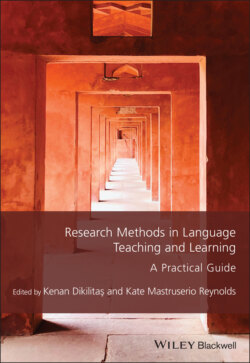Читать книгу Research Methods in Language Teaching and Learning - Группа авторов - Страница 23
Conclusions Methodological Issues
ОглавлениеSince the two individual case studies discussed above (Wyatt, 2010b, 2013a), I am unaware of any further TSE beliefs case studies of individuals teaching any subject. So, there still appear to be unfortunately only four, including Milner and Woolfolk Hoy (2003) and Mulholland and Wallace (2001), and there may be reasons for this. Firstly, three of these case studies (Mulholland & Wallace, 2001; Wyatt, 2010b, 2013a) were longitudinal, with data collected over several years. This was possible as the researchers were teacher educators who had access to participating teachers while they were in schools; conducting the research therefore represented an extension of work activity rather than a replacement of it. In contrast, longitudinal studies stretching over several years are likely to be beyond the scope of full-time doctoral students, since the costs that would incur while the data accumulate might be prohibitive (Cohen et al., 2011). So, in-depth investigations over shorter periods might be more practical. For example, Richard Milner spent 5 months in a school observing lessons daily as a doctoral student (Milner & Woolfolk Hoy, 2003); his study thus benefited from relatively “prolonged engagement” and “persistent observation” (Lincoln & Guba, 1985), which can enhance a study’s credibility. It can be difficult, though, in some cultures for doctoral students to gain access to in-service teachers’ classrooms; Phan (2015), who seemed to fully understand the benefits of observation as part of a case study approach to investigating (L)TSE beliefs, was given permission to observe lessons by only two of the eight university teachers in her collective case study set in Vietnam and observed these two twice each. She speculated that the other teachers might have felt threatened or have had negative prior experiences of being observed (Phan, 2015).
Since observations can be vital in working “the researcher towards greater understanding of the case” (Stake, 1995, p. 60), a lack of observational data appears to limit various (L)TSE beliefs collective case studies such as Filatov and Pill (2015). Rushton (2003), for example, used interviews, group discussions, and reflective writing, but not the observations and post-observation discussions that can focus investigations on particular classroom tasks. If the focus of the investigation is on task-specific TSE beliefs, observations can provide clues as to which self-directed goals (Henson, 2001) are most important to teachers, which can help the researcher focus the study, as in Mulholland and Wallace (2001) and Wyatt (2010b, 2013a), and gain insights into how efficacious the teachers are in carrying out specific tasks (Wyatt, 2008). From observations of teachers’ “body language, gestures, eye contact, choice of words or voice” (Wyatt, 2015, p. 123), the researcher can infer teachers’ apparent levels of self-efficacy, while continually questioning the basis for such inferences reflexively, and using the semi-structured interviews conducted subsequently to probe further. Such observations can also, of course, furnish insights into related factors, including the performative aspects of the teachers’ practical knowledge (Wyatt, 2010b; Wyatt & Borg, 2011).
Collective case studies that do not gather observational data suffer also from the limitation that it is harder to take the reader into the heart of the action through providing the “thick description” (Geertz, 1973) that can make the case strong on reality (Nisbet & Watt, 1984) and support vicarious experience in the reader, optimizing the reader’s opportunities to reflect and learn (Stake, 1995). However, even when observational data are drawn upon, it does not, of course, invariably follow that “thick description” (Geertz, 1973) will be used; for example, in a collective case study of six mathematics teachers that did employ observations, Katz and Stupel (2016) presented their qualitative data in a way that did not draw the reader into the teachers’ stories. Consequently, the strengths of case study, in focusing on the particularities of experience and providing readers “with good raw material for their own generalizing” (Stake, 1995, p. 102), were not fully exploited.
